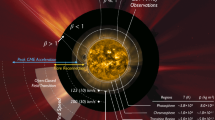Abstract
The Energetic Particle Telescope (EPT) is a new compact and modular ionizing particle spectrometer that was launched on 7 May 2013 to a LEO polar orbit at an altitude of 820 km onboard the ESA satellite PROBA-V. First results show electron, proton and helium ion fluxes in the South Atlantic Anomaly (SAA) and at high latitudes, with high flux increases during SEP (Solar Energetic Particles) events and geomagnetic storms. These observations help to improve the understanding of generation and loss processes associated to the Van Allen radiation belts.















Similar content being viewed by others
References
S. Benck, L. Mazzino, M. Cyamukungu, J. Cabrera, V. Pierrard, Low altitude energetic electron lifetimes after enhanced magnetic activity as deduced from SAC-C and DEMETER data. Ann. Geophys. 28, 848–859 (2010). www.ann-geophys.net/28/849/2010/
S. Benck, M. Cyamukungu, J. Cabrera, L. Mazzino, V. Pierrard, The Transient Observation-based Particle (TOP) model and its potential application in radiation effects evaluation. J. Space Weather Space Clim. 3, 1–10 (2013). doi:10.1051/SWSC/2013024
J. Cabrera, M. Cyamukungu, P. Stauning, A. Leonov, P. Leleux, J. Lemaire, G. Grégoire, Fluxes of energetic protons and electrons measured on board the Oersted satellite. Ann. Geophys. 23, 2975–2982 (2005). doi:10.5194/angeo-23-2975-2005
M. Cyamukungu, G. Grégoire, The Energetic Particle Telescope (EPT) concept and performances, in Proc. SPIE, vol. 8148, Solar Physics and Space Weather Instrumentation IV (2011), 814803. doi:10.1117/12.892420
M. Cyamukungu, S. Benck, I. Brivitch, W. Hajdas, G. Santin, A. Zadeh, A. Meniucci, P. Nieminen, R. Punkkinen, E. Valtonen, C. Semaille, B. Desoete, J. De Saedeleer, G. Creve, E. Van Ransbeeck, J. Maes, S. Bonnewijn, G. Grégoire, J. Cabrera, Perspectives for provision of high quality space radiation environment data using the Energetic Particle Telescope (EPT), in RADECS 2011, ed. by J. Schwank (Institute of Electrical and Electronics Engineers, 2011), pp. 569–572. doi:10.1109/RADECS.2011.6131438
M. Cyamukungu, S. Benck, S. Borisov, G. Grégoire, J. Cabrera, J.-L. Bonnet, B. Desoete, F. Preud’homme, C. Semaille, G. Creve, J. De Saedeleer, S. Ilsen, L. De Busser, V. Pierrard, S. Bonnewijn, J. Maes, E. Van Ransbeeck, E. Neefs, J. Lemaire, E. Valtonen, R. Punkkinen, M. Anciaux, K. Litefti, N. Brun, D. Pauwels, C. Quevrin, D. Moreau, A. Helderweirt, W. Hajdas, P. Nieminen, The Energetic Particle Telescope (EPT) on board PROBA-V: description of a new science-class instrument for particle detection in space. IEEE Trans. Nucl. Sci. (2014, submitted)
F. Darrouzet, V. Pierrard, S. Benck, G. Lointier, J. Cabrera, K. Borremans, N. Ganushkina, J. De Keyser, Links between the plasmapause and the radiation belts boundaries as observed by the instruments CIS, RAPID and WHISPER on CLUSTER. J. Geophys. Res. 118, 4176–4188 (2013). doi:10.1002/jgra.50239
D. Evans, H. Garett, I. Jun, R. Evans, J. Chow, Long-term observations of the trapped high-energy proton population (L<4) by the NOAA Polar Orbiting Environmental Satellite (POES). Adv. Space Res. 41, 1261–1268 (2008)
G.P. Ginet, T.P. O’Brien, S.L. Huston, W.R. Johnston, T.B. Guild, R. Friedel, C.D. Lindstrom, C.J. Roth, P. Whelan, R.A. Quinn, D. Madden, S. Morley, Y.-J. Su, AE9, AP9 and SPM: new models for specifying the trapped energetic particle and space plasma environment. Space Sci. Rev. 179(1–4), 579–615 (2013). doi:10.1007/s11214-013-9964-y
D. Heynderickx, Comparison between methods to compensate for the secular motion of the South Atlantic Anomaly. Nucl. Tracks Radiat. Meas. 26, 325–331 (1996)
D. Heynderickx, M. Kruglanski, V. Pierrard, J. Lemaire, M.D. Looper, J.B. Blake, A low altitude trapped proton model for solar minimum conditions based on SAMPEX/PET data. IEEE Trans. Nucl. Sci. 46, 1475–1480 (1999)
M. Kruglanski, Engineering tool for trapped proton flux anisotropy evaluation. Radiat. Meas. 26, 953 (1996)
P. Maisongrande, J. Vandenabeele, J.-P. Malingreau, A. Lobo, P. de Fourny, E. Gonthier, K. Mellab, R. Kleihorst, PROBA-V, a satellite for the continuity of the SPOT/VEGETATION mission. Geophys. Res. Abstr. 12, EGU2010-14202-1 (2010)
C.E. McIlwain, Coordinates for mapping the distribution of magnetically trapped particles. J. Geophys. Res. 66, 3681–3691 (1961)
V. Pierrard, S. Benck, The dynamics of the terrestrial radiation belts and its links to the plasmasphere, in Space Weather: the Space Environment. AIP Conf. Proc., vol. 1500 (2012), p. 216. doi:10.1063/1.4768769
V. Pierrard, K. Borremans, Fitting the AP8 spectra to determine the proton momentum distribution functions in space radiations. Radiat. Meas. 47, 401–405 (2012). doi:10.1016/j.radmeas.2012.04.002
V. Pierrard, J. Lemaire, Fitting the AE-8 energy spectra with two maxwellian functions. Radiat. Meas. 26(3), 333–337 (1996)
V. Pierrard, J. Lemaire, D. Heynderickx, M. Kruglanski, M. Looper, B. Blake, D. Mewaldt, Statistical analysis of SAMPEX/PET proton measurements. Nucl. Instrum. Methods Phys. Res. 449, 378–382 (2000)
J.-A. Sauvaud et al., Radiation belt electron precipitation due to VLF transmitters: satellite observations. Geophys. Res. Lett. 35, L09101 (2008). doi:10.1029/2008GL033194
J.-A. Sauvaud et al., Inner radiation belt particle acceleration and energy structuring by drift resonance with ULF waves during geomagnetic storms. J. Geophys. Res. 118, 1723–1736 (2013). doi:10.1002/jgra.50125
Y.Y. Shprits, S.R. Elkington, N.P. Meredith, D.A. Subbotin, Review of modeling of losses and sources of relativistic electrons in the outer belt I: radial transport. J. Atmos. Sol.-Terr. Phys. 70, 1679–1693 (2008a). doi:10.1016/j.jastp.2008.06.008
Y.Y. Shprits, S.R. Elkington, N.P. Meredith, D.A. Subbotin, Review of modeling of losses and sources of relativistic electrons in the outer belt II: local acceleration and loss. J. Atmos. Sol.-Terr. Phys. 70, 1694–1713 (2008b). doi:10.1016/j.jastp.2008.06.014
A.L. Vampola, VLF transmission-induced slot electron precipitation. Geophys. Res. Lett. 4, 569–572 (1977)
J.I. Vette, The AE-8 trapped electron model environment. NSSDC/WDC-A-R&S 91-24 (1991)
Acknowledgements
V. Pierrard and the Space Physics Department of BISA thank the Belgian Science Policy—Space Research and Applications (Belspo) for the supplementary researcher program entitled “Scientific analysis of EPT (Energetic Particle Telescope) measurements”. The research leading to these results has also received funding from the European Union’s Seventh Programme for Research, Technological Development and Demonstration under Grant Agreement n°263340 SWIFF (www.swiff.eu) and was subsidized by the Scientific Federal Policy in the framework of the program Interuniversity Attraction Pole for the project P7/08 CHARM.
The development of the EPT instrument was realized with the support of the Belspo and of the European Space Agency (ESA) (contracts 20294/06/NL/JD (Phase A/B) and 22582/09/NL/AT (Phase C/D)). The design of the EPT instrument and its integration on the PROBA-V satellite results from a fruitful Consortium between the Université Catholique de Louvain, the Belgian Institute for Space Aeronomy and QinetiQ Space. The B.USOC and the control center in Redu provide data transmission and storage. The authors thank all the scientists who temporarily participated to the development of the EPT instrument and its integration on PROBA-V satellite, as well as the administrative teams of the different institutes. The CSR team also thanks Belspo for supporting the “PROBA-V/EPT – Data Exploitation” project via the PRODEX program under ESA contract C4000107617) and for the PRODEX-7 (N° 90098+ CCN-1/C 90098). They also thank G. Tabordon, L. Kruijfthooft, C. Thielens, B. de Callatay and the radioprotection and cyclotron teams. EPT data can be consulted on the website http://web.csr.ucl.ac.be/csr_web/probav/index.html.
The authors thank the reviewers for their suggestions to improve the manuscript, especially for the comparisons with Van Allen Probes. The authors thank also Drs S. Bourdarie and V. Maget from ONERA in Toulouse (France) for providing the observations of SAC-D and POES that were used for comparisons with EPT measurements and for many useful discussions to improve the analysis of the data.
Author information
Authors and Affiliations
Corresponding author
Rights and permissions
About this article
Cite this article
Pierrard, V., Lopez Rosson, G., Borremans, K. et al. The Energetic Particle Telescope: First Results. Space Sci Rev 184, 87–106 (2014). https://doi.org/10.1007/s11214-014-0097-8
Received:
Accepted:
Published:
Issue Date:
DOI: https://doi.org/10.1007/s11214-014-0097-8




